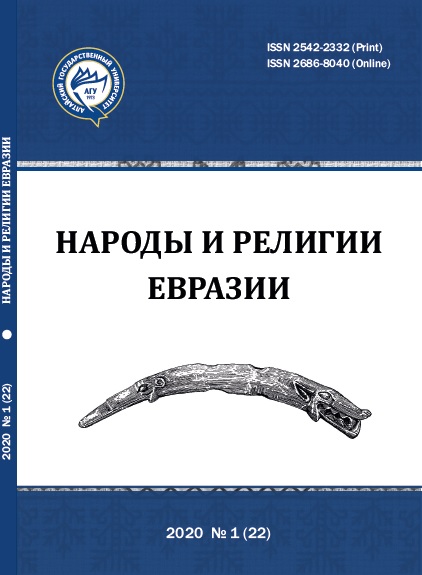The ethnoconfessional portrait of Anatasians by the materials from Novosibirsk oblast
Main Article Content
Abstract
“The Ringing Cedars of Russia”, the Anastasia movement, the cult of Anastasia, the Anastasians — that is several names for the fans Vladimir Megre’s ideas. He made them public by his series of ten books called “Ringing cedars of Russia”. These literary works contains the revelation of the fictional person — a woman named Anastasia. The fandom of Anastasia inspired by her ideas develops as an urban community, preaching the mythology of the Golden Age and Paradise lost as well as the concept of ecologism expressed by Megre. Then Anastasians began to carry out the program of moving out of cities and returning to the soil. To return to the soil for the adherents of Anastasia means to create their own family estate as a small homeland. So, having appeared in 1996, the movement has evolved from clubs of admirers of “ideas of Anastasia” to hundreds of settlements of family estates in Russia and abroad. The cultural model for the community is the idea of Vedrussia — the mythical civilization of the ancient Slavs. The main features of the Anastasia movement as an ethno-confessional one are the following: the author’s myth as a base, the reference to the origins, the revival of primordial traditions, elements of pantheism and magical practices of the participants.
Downloads
Metrics
Article Details

This work is licensed under a Creative Commons Attribution 4.0 International License.
References
Мегре В. Звенящие кедры России. СПб. : Диля, 1997. 384 с.
Юнг К.-Г. Человек и его символы. М., 1998. 454 с.
Мегре В. Звенящие кедры России. СПб. : Диля,1997. 384 с.
Мегре В. Новая цивилизация. Ч. 2. Обряды любви. СПб. : Диля, 2006. 224 с.
Мегре В. Анастасия. СПб. : Диля, 1996. 224 с.
Мегре В. Родовая книга. СПб. : Диля, 2002. 256 с.
ПМА: Письмо В. Бородина, 30.09.2019.
ПМА: Письмо И. Беспалова, 21.03.2019.
ПМА: Сообщение И. Новосёлова, 8.08.2016.
ПМА: Сообщение М. Шумигай, 24.11.2017.
ПМА: Письмо Н. Вятки, 4.10.2019.
ПМА. Письмо Н. Вятки, 22.02.2019.
ПМА: Интервью с М. Тимониной, 01.06.2016.
ПМА: Письмо А. Ведова, 24.02.2019.
ПМА: Письмо Н. Козыревой-Анисимовой, 24.01.2019
ПМА: Письмо Н. Вятки, 5.03.2019.
ПМА: Интервью с В. Старицыным, 6.05.2016.
ПМА: Письмо Н. Козыревой-Анисимовой, 26.01.2019.
ПМА: Письмо Ю. Осиповой, 18.02.2019.
ПМА. Письмо А. Дьяковой, 22.02.2019.
ПМА. Письмо О. Даниленко, 19.02.2019.
ПМА: Интервью с П. Подшиваловым, 30.04.2016.
ПМА: Письмо К. Чемерис, 23.05.2016.
ПМА: Интервью с М. Тимониной, 30.04.2016.
ПМА: Письмо А. Бояриновой, 5.03.2019.
ПМА: Письмо И. Беспалова, 23.03.2019.

